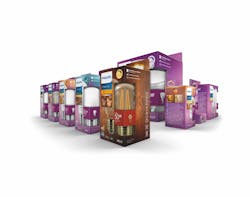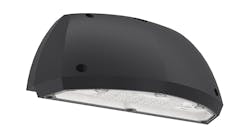The 1967 classic film The Graduate is memorable for all sorts of things. Among them are the lyrics “Here’s to you, Mrs. Robinson,” and the questionable promise of plastics.
Well, here’s to you Mr. Rondolat.
Signify CEO Eric Rondolat has set his company on course to eliminate plastic from all of its consumer product packaging within the next 18 months.
The initiative began earlier this year in Australia and New Zealand. It will take hold in Europe on July 1 and will roll out afterward in other regions, all of which together aim to cut out plastic from the boxes, cartons, and packs used for Philips bulbs, Hue electronics gear, and any other consumer items from the world’s largest lighting company by the end of 2021.
Signify said the action will avoid an amount of the material equal to a line of half-liter water bottles stretching about 5000 miles, or from the north of Norway to Gibraltar and back as the crow flies. For tonnage fans, that’s 2500 metric tons (tonnes), or 2756 US tons.
However you measure, it’s a lot of plastic that won’t have the chance to wreak environmental damage, such as in oceans where it kills seabirds, fish, and marine mammals.
See also: Signify withdraws 2020 outlook, declines rescheduled L+B
“Plastic waste has a very negative impact on our planet and its biodiversity, and we decided that we must take a leading role and start using plastic-free alternatives,” said Rondolat, who announced the program today. “It is the right thing to do and meets the increasing expectations of our customers. I look forward to the moment that we can announce that we no longer use plastics in our packaging.”
Signify is banishing plastic items such as foam inserts from boxes, film coverings from box windows, clear hard coverings that protect bulbs on “blister packs” (the cardboard sheets with cavities that hold bulbs), and plastic hooks used to hang packages from retail racks.
In their place, the company is shifting to more use of paper, with at least 80% of that paper to be from recycled sources and with any virgin materials coming from certified renewable sources, Signify said. In the case of bulb boxes with a window, those windows will not be covered with any material but will be open. To control paper use, Signify is generally reducing the size of its packaging, which will have the added environmental benefit of reducing transportation costs and its CO2 emissions.
See also: Lighting as a service poised to deliver the circular economy
The company has been using plastic in about 50% of its consumer packaging. For now, Signify will continue to use plastic in packaging on commercial and industrial products, although the amount is small, a spokesperson told LEDs.
Asked during a roundtable discussion with journalists about cost and price, Signify sustainability manager Robbert Slooten said that while the initiative will “have different impacts across the value chain,” end-user pricing is not expected to increase.
That’s a potential koo-koo-ka-choo for consumers, in more ways than one.
MARK HALPER is a contributing editor for LEDs Magazine, and an energy, technology, and business journalist ([email protected]m).
For up-to-the-minute LED and SSL updates, why not follow us on Twitter? You’ll find curated content and commentary, as well as information on industry events, webcasts, and surveys on our LinkedIn Company Page and our Facebook page.






